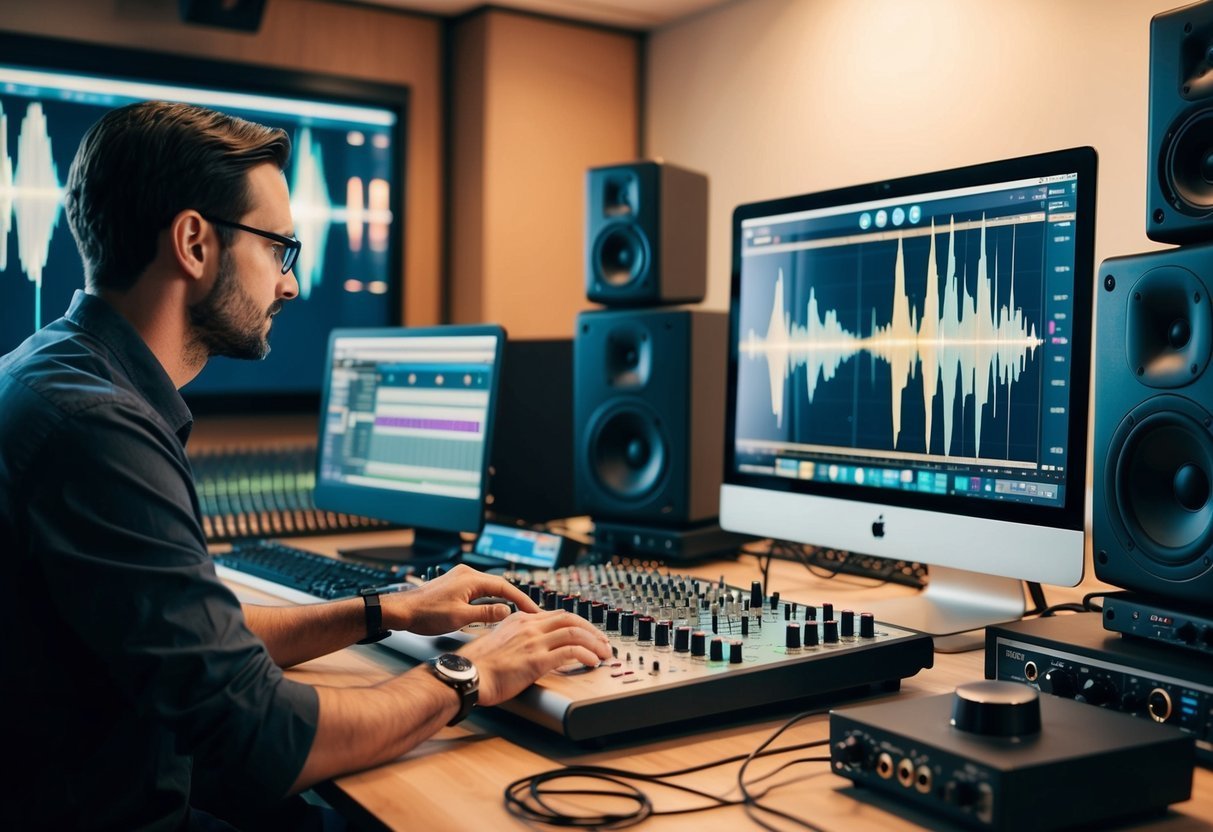Are you ready to embark on a journey into the world of sound design? Whether you’re laying down your first tracks or looking to step up your production game, sound design is a crucial skill that can transform your music.
As an aspiring producer, you must understand the basic properties of sound—such as frequency, amplitude, and timbre.
These will give you the tools you need to craft unique soundscapes.
Sound design is your artistic playground, where you take raw auditory materials and mold them into something captivating. By mastering the use of Digital Audio Workstations (DAWs), you can record, edit, and manipulate sounds to create a track that’s truly your own.
Embracing these fundamentals equips you with the ability to move beyond presets and develop your own distinct sonic identity.
Developing good listening skills and paying attention to sonic details are essential in this endeavor.
These skills help you refine your work and ensure that each element of your music contributes to the overall experience.
So, dive into sound design, and watch how it elevates your music production journey.
The Essence of Sound Design
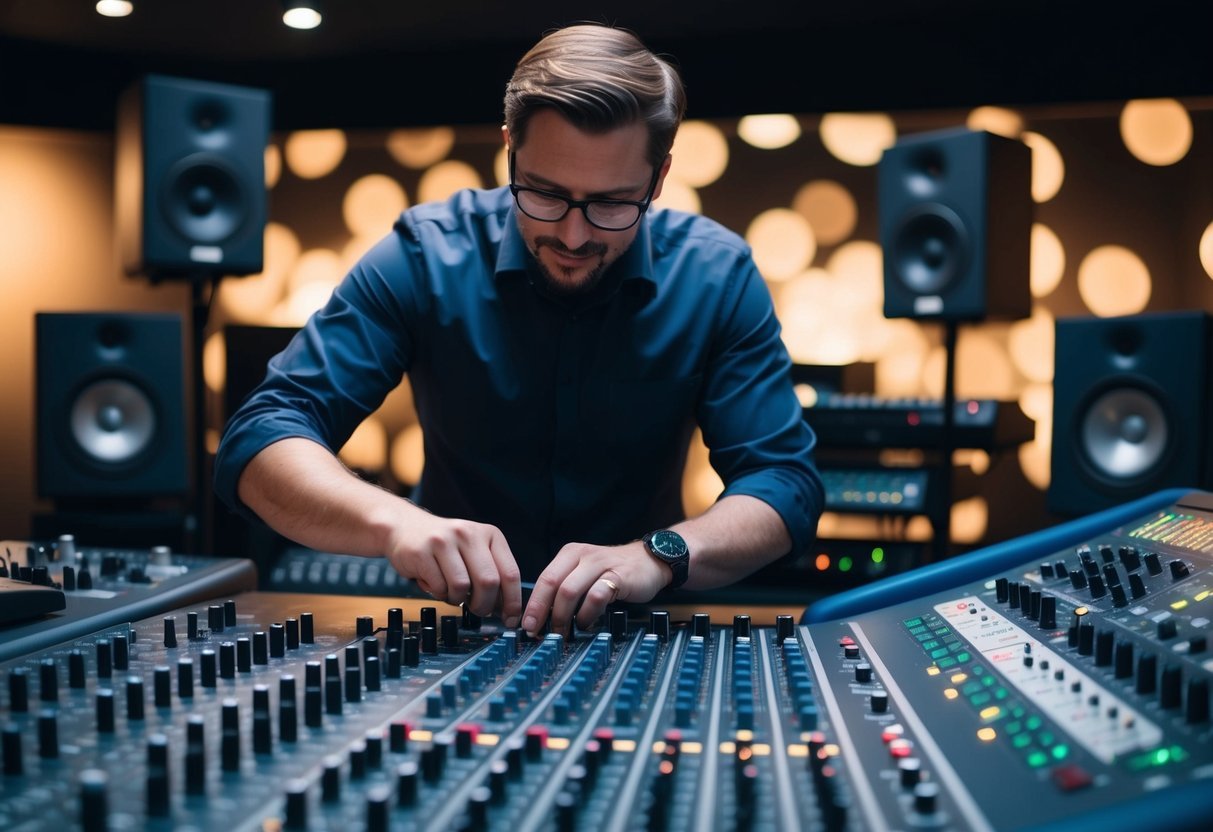
Sound design is crucial for shaping the auditory experience across different media formats.
It involves creating and manipulating sound elements to enhance the storytelling and emotional impact of any production, whether in film, television, games, or music.
Defining Sound Design
You might wonder what makes up sound design.
At its core, sound design is all about crafting and arranging audio elements to create immersive and engaging experiences.
It goes beyond just adding effects or music; it’s about transforming raw audio into something that deeply resonates with the audience.
Sound designers work with elements like frequency, amplitude, and timbre, using tools such as DAWs (Digital Audio Workstations) to edit and refine sounds.
This process often involves manipulating overtones, utilizing filters, and experimenting with different synthesis techniques to create unique soundscapes.
Sound Design in Different Media
In film and television, sound design shapes the narrative landscape, setting the tone and conveying emotion through well-crafted audio elements.
It brings stories to life by filling silent moments with mood-setting soundscapes and intense action sequences with powerful effects.
For game audio, sound design is even more interactive.
You’re creating a dynamic auditory environment that responds to player actions and enhances the gameplay experience.
Crafting sounds for games often involves unique challenges, such as seamless audio loops and ensuring sounds are triggered precisely when needed.
Whether it’s the subtle ambiance of a city street in a film or the exhilarating sound of a video game explosion, every element counts in building a memorable auditory experience for the audience.
The Producer’s Toolkit
When diving into sound design, you’ll need a solid collection of tools.
These include Digital Audio Workstations (DAWs) for arranging your tracks, Virtual Instruments for creating diverse sounds, and various Sound Design Tools to refine your audio creations.
Each component is essential in elevating your music production skills.
Digital Audio Workstations (DAWs)
A Digital Audio Workstation is your central hub for all music production tasks. Ableton Live and Logic Pro X are popular choices for producers thanks to their intuitive interfaces and robust features.
Ableton Live is great for live performances and offers a flexible workflow.
It’s particularly useful for electronic and experimental genres.
Meanwhile, Logic Pro X is favored for its comprehensive suite of production tools and is ideal for a polished studio environment.
Both offer a range of built-in effects and plugins that can help with everything from mixing to mastering.
Understanding your DAW’s capabilities will greatly impact your production quality.
Virtual Instruments
Virtual Instruments expand your creative palette by simulating real-world sounds and creating entirely new sonic textures.
Synthesizers like Xfer Serum and Native Instruments FM8 are popular because of their versatility and power.
Xfer Serum is prized for its visual and accessible interface, allowing you to create complex waveforms with ease.
Meanwhile, FM8 stands out for its vast array of presets and modulation possibilities, making it a go-to for unique soundscapes.
Many DAWs also include built-in instruments, but exploring third-party options can open even more possibilities for your sound design endeavors.
It’s about finding the right tools that enhance your creative vision.
Sound Design Tools
Your toolkit should also include specialized sound design tools that allow precise audio manipulation.
Plugins for effects like reverb, compression, and equalization are vital.
Tools like FabFilter Pro-Q3 for EQ and Valhalla reverb plugins enhance and modify your audio layers.
Synthesizers, both hardware and software, also play a big role here.
They provide a range of sound-shaping features like oscillators and filters.
Using these tools, you can sculpt audio textures down to the finest detail, turning your raw ideas into fully realized compositions.
Always stay up to date with the latest plugins and updates to keep your sound current.
Technical Foundations of Sound
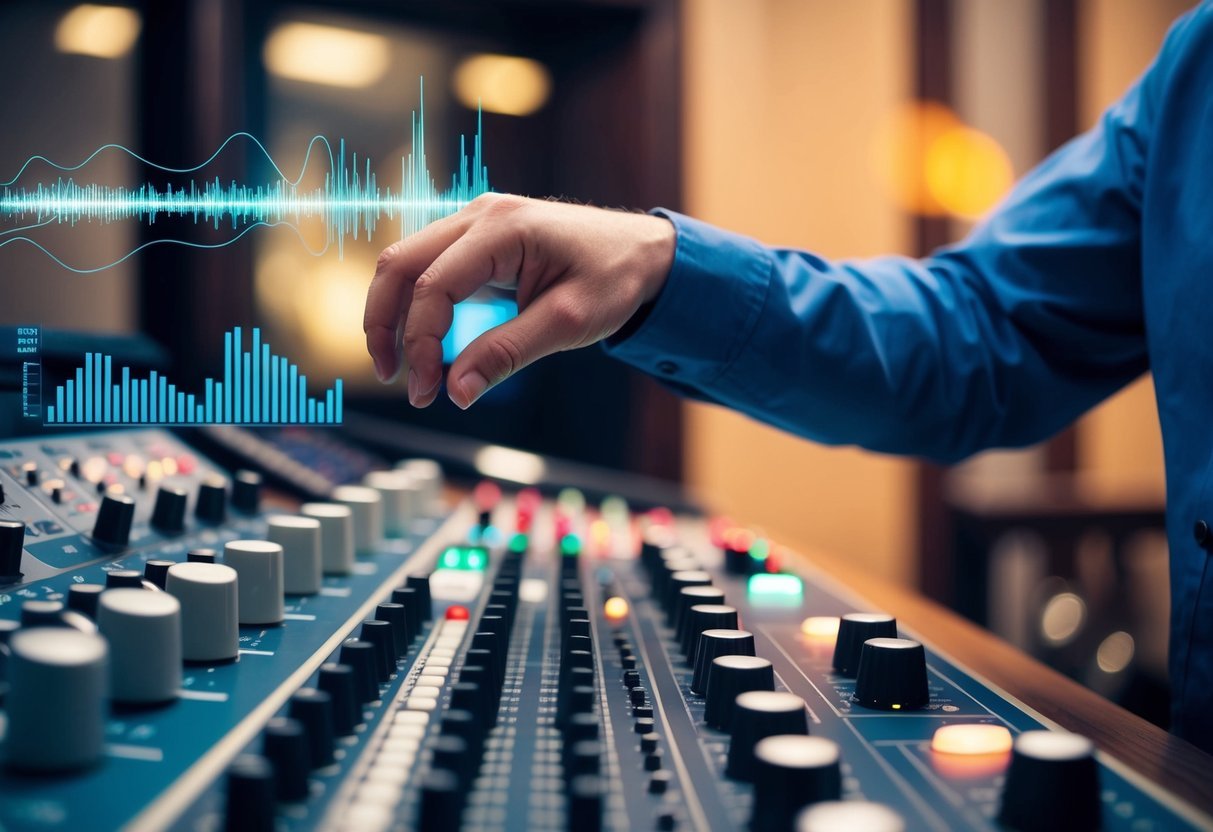
Understanding the fundamental elements of sound, like timbre, texture, frequency, pitch, and harmonics, is crucial for any aspiring producer.
These components shape the character and color of sound, making them essential tools in sound design.
Understanding Timbre and Texture
Timbre is what gives a sound its unique quality, setting it apart from others even if they’re at the same pitch and loudness.
It’s like the texture of sound, allowing you to distinguish a piano from a guitar playing the same note.
Factors like the instrument’s material and construction play a part.
Texture, on the other hand, refers to the layers in a piece of music.
Whether it’s a complex symphony or a simple melody, texture helps create depth and richness.
As a producer, understanding texture can help you craft intricate soundscapes that engage and captivate listeners.
Use these concepts to manipulate sounds in innovative ways.
The Role of Frequency and Pitch
Frequency refers to the number of times a wave oscillates per second, measured in hertz (Hz).
It directly influences the pitch of a sound—the higher the frequency, the higher the pitch.
This is essential for creating melodies and harmonies in your tracks.
Pitch is how your ear perceives frequency.
By using tools like equalizers and synthesizers, you can shape the pitch and frequency to fit your creative vision.
Whether you’re creating bass lines or high melodies, understanding pitch will help you control the emotional impact of your music.
Harmonics and Sound Color
Harmonics are the overtones that occur alongside a fundamental frequency, adding richness to the sound.
They contribute to the “color” of the sound, making it fuller and more vibrant.
Harmonics can be manipulated using various synthesis techniques.
Sound color, or timbral quality, can be adjusted by altering the harmonic content.
By tweaking how harmonics are balanced and shaped, you can dramatically change the character of a sound.
This is vital for creating unique sonic signatures that stand out in a noisy musical landscape.
Get creative with harmonics to enhance your productions.
Synthesis Basics
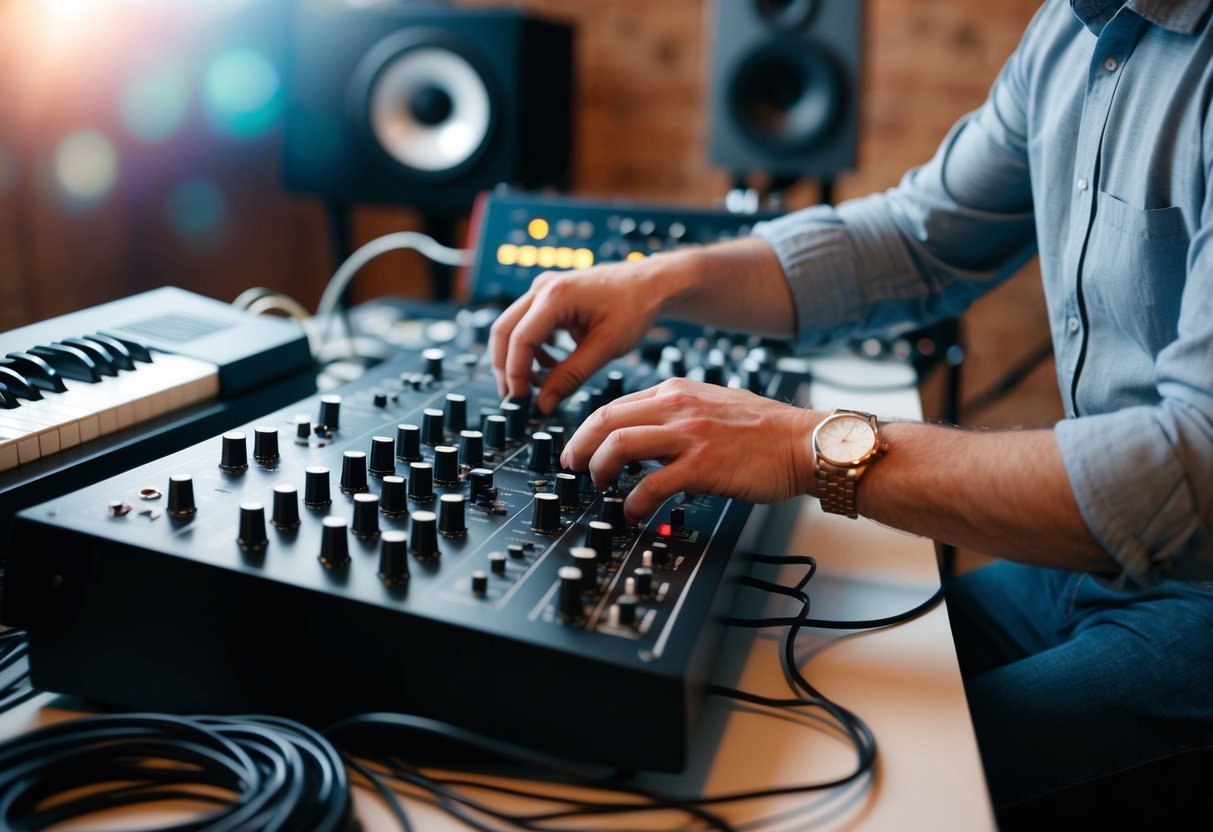
Synthesis in music production involves creating sound through various techniques.
It often starts with oscillators generating waveforms and progresses through filters and envelopes.
Understanding different synthesis methods enhances your ability to manipulate sound.
Oscillators and Waveforms
When you dive into synthesis, you’ll first encounter oscillators.
They are fundamental components that produce waveforms such as sine, square, triangle, and sawtooth.
These waveforms are the building blocks of audio synthesis.
Each waveform has a distinct sound quality. Sine waves are pure tones, making them ideal for simple bass sounds.
In contrast, square waves have a rich harmonic content, suitable for digital-sounding leads.
Understanding these characteristics helps you choose the right waveform to match your sound objectives.
The oscillator’s pitch can be adjusted, and multiple oscillators can be layered for a richer sound.
Experiment with tuning them to create detuned or harmonic effects, which can add depth to your music.
Exploring these basics will set a solid foundation for your synthesis journey.
Exploring Filters and Envelopes
Filters and envelopes are powerful tools for shaping sound.
Filters modify the frequency content of your audio by removing certain frequencies.
The most common type is the low-pass filter, which removes high frequencies, leaving a smoother sound.
You can also use high-pass filters to do the opposite, allowing high frequencies through while cutting low frequencies.
These tools let you sculpt your audio precisely to fit your mix.
Envelopes control how a sound evolves over time, typically affecting parameters like amplitude (volume) and filter frequency.
The typical envelope components are Attack, Decay, Sustain, and Release (ADSR).
Adjusting these stages influences how quickly the sound starts, how it changes after the initial hit, and how it fades out.
Mastering filters and envelopes gives you detailed control over your sound.
Introduction to Synthesis Methods
Several synthesis methods offer unique sound design opportunities. Subtractive synthesis starts with rich, harmonic waveforms and uses filters to “subtract” unwanted frequencies.
It’s great for classic analog sounds.
Additive synthesis builds sound by combining simple waveforms like sine waves, allowing for intricate timbral control.
It’s perfect for creating complex textures.
FM synthesis (Frequency Modulation) is a bit more complex, using one waveform to modulate another, which can produce bright, evolving tones.
Lastly, wavetable synthesis involves using different waveforms stored in tables, blending between them to generate diverse sonic possibilities.
Each method has its own characteristics, so experimenting with them will broaden your sound design palette.
Sampling and Audio Manipulation
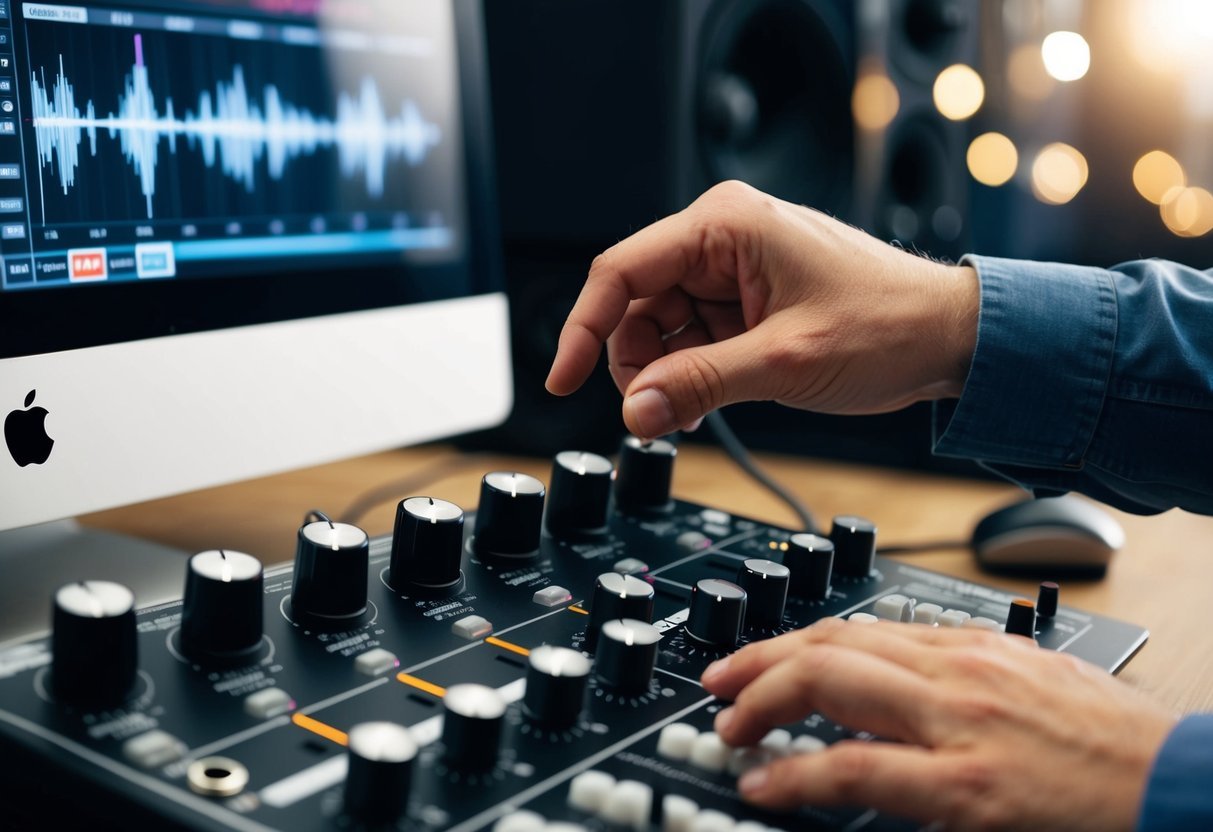
Unlocking the creative potential of sound design often starts with sampling and manipulating audio.
This part of music production focuses on utilizing samples, modulating sound, and creatively editing audio to create something unique and compelling.
The Art of Sampling
Sampling is like the secret spice in the music production kitchen.
You take a snippet from an existing piece of music, a rhythm, or even ambient sounds, and reimagine it in your track.
Samplers allow you to chop, stretch, and layer these audio bits.
This process involves choosing the right moments from audio and skillfully integrating them into your compositions. Time-stretching lets you adjust the tempo or pitch without compromising quality, adding flexibility to your creative process.
Modulation Techniques
When it comes to modulation, think of it as the tool for injecting movement and emotion into your tracks. Modulation transforms sound frequencies and amplitudes, adding depth and vibrancy.
You can apply techniques like filtering, where you adjust the frequency content of your sample, or LFO, which adds variety through rhythmic modulation.
These methods help in shaping the texture and dynamism of your music, allowing it to come alive.
Creative Audio Editing
Audio editing is where you shape and polish your sounds, using tools to refine or invent new audio elements.
Techniques such as reversing audio can add an unexpected twist, flipping sounds to create tension and interest.
Layering and chopping allow you to build complex arrangements from simple samples.
By combining these with effects like reverb or delay, you enhance your soundscape.
Experimentation here is key—each edit can lead to unexpected results and innovative tracks.
Crafting Unique Sounds
Creating unique sounds in music production involves developing a personal audio aesthetic and going beyond standard presets.
This requires exploring various sound synthesis techniques and recording methods to shape fresh, original tones.
Developing a Unique Audio Aesthetic
Finding your audio aesthetic means figuring out what makes your sound stand out.
Start by experimenting with different instruments and effects in your Digital Audio Workstation (DAW).
Try blending natural recordings with synthetic sounds to create something fresh.
Spend time listening to various genres, and let them influence your creations.
Craft your aesthetic by incorporating uncommon elements—like field recordings or experimental effects.
Consider using software synthesizers such as Omnisphere or Serum.
These synthesizers are known for their vast libraries and customization options.
Elements like these can add depth and texture that make your sound memorable.
Beyond Presets: Crafting Original Sounds
Moving past presets opens up a world of sound creation possibilities.
Start by exploring the settings of your chosen synthesizer—adjust waveforms, filters, and envelopes.
Using tools like Serum, you can visually see changes in your sound, making it easier to refine your work.
Engage in sound synthesis by blending simple waves to create complex textures.
Record your sounds, whether that’s capturing ambient noises or using unconventional instruments, to develop a library of unique samples.
This provides raw material to craft truly original sounds that reflect your vision.
Enhancing Audio with Effects

Audio effects can transform your tracks by adding depth, texture, and color.
They help in crafting a unique sound that stands out and can also eliminate unwanted elements such as background noise.
Using Reverb and Delay
Reverb and delay are time-based effects used to create space and dimension in your productions. Reverb simulates how sound reflects in a room, adding a sense of location and atmosphere.
Whether you want a cozy small room feel or a vast hall ambiance, reverb settings let you control that spatial impression.
Delay provides a repeating echo effect that can emphasize certain parts of a track.
By adjusting the time between repetitions, you can create anything from subtle spatial enhancement to rhythmic pulse effects.
Use delay to fill out soundscapes or create complex harmonies.
When used together, reverb and delay allow for rich and layered textures that can elevate your music’s emotional and aesthetic appeal.
Just be sure to adjust them carefully to avoid muddying the mix or losing the clarity of the original recording.
Distortion and Textural Effects
Distortion is like the spice in your audio kitchen, adding grit and presence to your sounds.
It pushes audio signals to their limits, introducing harmonic overtones that make instruments sound more aggressive and lively.
Whether it’s a gentle warmth or a heavy crunch, distortion can dramatically alter the feel of your tracks.
Textural effects go beyond just volume and frequency adjustments.
They include techniques like using notch filters to cut specific frequencies, removing harsh tones, or isolating unique characteristics in your sound.
These kinds of adjustments highlight particular elements, giving your audio more character.
By carefully using these effects, you can add richness and interest, making your productions stand out both dynamically and tonally.
Mixing for Sound Design
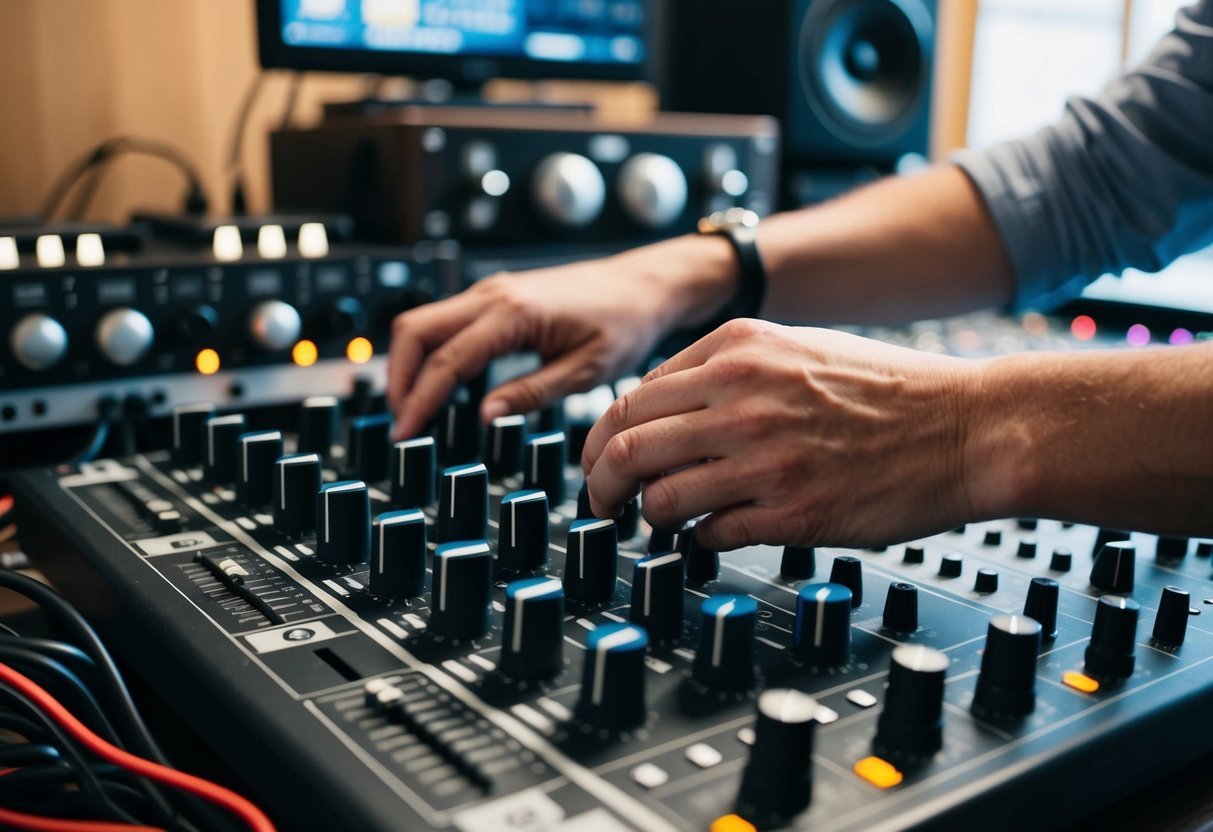
Sound mixing in sound design involves blending various audio elements to create a cohesive piece.
This process uses equalization to adjust frequency components and enhance the clarity and balance of the mix.
The Basics of Sound Mixing
When starting with sound mixing, you work with signal flow, an essential concept that lets you understand how audio flows from one component to another.
It’s important to manage levels, ensuring none of the sounds overpower others unless intentionally.
You might often start by balancing each element — vocals, instruments, or effects.
With each component sitting at the right level, you create a foundation.
Use panning to place sounds spatially across stereo fields.
This makes your mix more immersive, allowing each element to have its own space in the auditory spectrum.
Experimentation is key.
As you mix, try different approaches and listen critically using headphones and speakers.
Always trust your ears to guide you through this creative practice.
It eventually becomes about finding harmony among all sounds combined.
Equalization in Sound Design
Equalization, or EQ, shapes and modifies the frequency response of individual sounds within a mix.
You’ll use EQ to highlight certain aspects, like enhancing bass for depth or reducing mids for clarity.
Start by understanding the different frequency ranges: bass, mid-range, and treble.
Adjust these bands to sculpt the tones appropriately.
It’s common to use a parametric equalizer, which allows you to make precise changes to specific frequencies.
Sometimes, you’ll need to remove unwanted noise.
Apply low-cut filters to eliminate unnecessary low-end rumble or high-cut to reduce unwanted hiss.
EQ isn’t just a corrective tool but a creative one.
Play around to discover tones and textures that fit your vision, always keeping the end listener in mind.
Your adjustments should allow each sound to shine without clashing with others.
Music and Composition Techniques
In sound design for music producers, a solid grasp of music and composition techniques can greatly enhance the creative process.
You’ll find these skills useful not only in creating music but also in integrating your sound design into different projects like film scoring.
Composition for Sound Designers
When you’re working on sound design, understanding composition is a game-changer.
It begins with knowing how to create melodies, harmonies, and rhythms that suit your project.
You should explore different musical scales and chord progressions to add depth and emotion to your sound designs.
For film scoring, compositions need to evoke specific emotions and match the on-screen action.
This requires a blend of creativity and technical knowledge.
Using tools like digital audio workstations (DAWs) and virtual instruments can help you craft intricate compositions easily.
Experimenting with tempo and key changes can lead to unexpected and unique results.
Don’t shy away from using unconventional sounds and rhythms as they can provide a fresh perspective to your compositions.
Integrating Music and Sound Design
Blending music and sound design involves more than just adding sound effects to a track.
There’s a need for harmony between your sound design elements and the musical composition.
Balancing these elements requires attention to timbre and frequency.
You can create a seamless integration by aligning your sound design with the existing musical elements.
For instance, matching the key or tempo can prevent any clashes and create a cohesive sound landscape.
Consider the context in which your work will be used.
In film scoring, aligning sound design with narrative cues is essential.
This means timing your sound effects to match scene shifts or character actions, creating a more immersive experience for the audience.
Careers in Sound Design
Sound design is a dynamic field offering a variety of career paths in music, film, video games, and more.
Armed with the right education, an impressive portfolio, and solid networking skills, you can pave your way to success.
Educational Paths
To get started, pursuing a degree in sound design or a related area like audio engineering can be beneficial.
This education equips you with essential technical knowledge and practical skills.
Courses often delve into sound design techniques, using industry-standard software to explore its artistic components.
While a degree isn’t mandatory, it provides a structured learning environment and valuable exposure.
Another option is learning through hands-on experience, which involves engaging with sound design fundamentals on your own.
This path often requires dedication and self-discipline.
Many successful sound designers began by experimenting with audio equipment and online resources, gradually gaining competence.
Building a Portfolio
Creating a compelling portfolio is crucial.
Focus on showcasing your best work to highlight your skills in different areas, from music and film to games.
Each piece should demonstrate your technical proficiency and creativity in sound design.
Strengthen your portfolio by collaborating with composers, musicians, and other creatives.
These opportunities not only add diverse work to your collection but also help you learn new techniques.
Incorporating well-annotated project descriptions can be immensely beneficial.
Clearly explain your role, the techniques used, and the challenges addressed.
This documentation provides potential employers insight into your problem-solving capabilities and artistic approach.
Consider using an online platform or a personal website to present your work professionally.
Networking and Career Opportunities
Building relationships is key in advancing your sound design career.
Attend industry events and workshops to connect with professionals and peers.
These gatherings are excellent for learning about emerging trends and establishing yourself in the sound design community.
Networking isn’t limited to in-person events.
Use social media platforms and audio communities to reach out to other professionals, share your work, and seek feedback.
Engaging in online discussions can lead to valuable connections and potential collaborations.
Consider seeking mentorship opportunities from experienced sound designers.
A mentor can provide guidance, open doors to new opportunities, and help you navigate the professional landscape.
Networking not only exposes you to job prospects but also enriches your understanding of the field.
Frequently Asked Questions
Getting started with sound design involves building skills and selecting the right tools.
Sound design plays a crucial role in music production, enhancing creativity and adding depth.
Here are answers to some common questions that many beginners have.
What’s the first step for learning sound design?
The first step is learning how to use a Digital Audio Workstation (DAW).
A DAW helps you record, edit, and manipulate audio files, which is essential for sound design.
Familiarize yourself with its interface and capabilities to start experimenting with different sounds.
Why is sound design so important for music production?
Sound design is vital because it can transform basic elements, like a melody or a drum loop, into something more immersive and engaging.
It allows you to create unique sonic textures and moods that are essential for building emotion in music.
Can you name a few basic sound synthesis techniques?
Sure! Some basic sound synthesis techniques include subtractive synthesis, which removes frequencies from a sound, FM synthesis that uses frequency modulation, and wavetable synthesis, which involves morphing between different waveforms.
How does a newbie get started with creating their own sounds?
Begin by experimenting with sampling and synthesis.
You can record and edit audio or create new sounds using analog or digital synthesizers.
Start simple and gradually explore different tools and techniques.
Participate in online communities and tutorials to enhance your skills.
What gear do sound designers recommend for new producers?
A good pair of studio monitors or headphones is essential for accurate sound representation.
A reliable laptop or desktop with sufficient processing power is critical.
Additionally, consider getting a MIDI controller and a basic audio interface to expand your capabilities.
How long does it typically take to get good at sound design?
The timeframe can vary.
It often takes several months to years to become proficient.
It largely depends on your dedication and practice routine.
Regular practice and learning from tutorials can help you improve.
Experimenting with new techniques also contributes to honing your skills.

